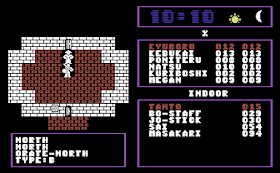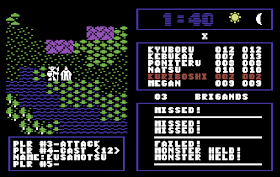 |
| Some of the missions involved defeating a "black master." |
Time Horn: Il Corno del Tempo
Italy
Lindasoft (developer and publisher)
Released in 1991 for Amiga
Date Started: 1 June 2017
Date Ended: 10 June 2017
Date Ended: 10 June 2017
Total Hours: 9
Difficulty: Hard (4/5)
Final Rating: 29
Ranking at Time of Posting: 136/253 (54%)
Ranking at Game #457: 267/457 (58%)
This will be the first time that I wrap up a game based on the experiences of a commenter, but Zardas did such a good job filling in the next stages of the game that I feel like it would simply be a waste of time if I did it myself. He also cheated to give himself invincibility and unlimited movement, so it would have taken me 10 times as long just to arrive at the same conclusion.
 |
| I had the hardest time even getting this screen. |
I did play a little more on my own, but I continued to have problems that even Zardas didn't seem to experience, including characters who "died exhausted" no matter how much food and water I gave them and an inability to get out of the mission even after achieving its goal and returning to the starting location to end my turn. Also, the documentation never turned up to explain exactly why we were on these various missions in the first place.
The primary reason, of course, for declining to experience the rest of the game myself is Zardas's report that the final mission crashes with an error message. I realize this sort of thing happens under certain circumstances that I might not have experienced, but I still wasn't going to risk wasting that kind of time on a game that I probably wouldn't be able to complete.
 |
| Not the kind of thing you want to see after completing 15 missions. |
Based on what we know about the game so far, I give it:
- 3 points for a short backstory that does an adequate job setting up the adventures to come. If the manual ever turns up, I may decide it deserves more here.
 |
| Mordred begins to make a name for himself. Funny how this is in English. |
- 2 points for character creation and development. There's no creation at all, and based on Zardas's reports, the max of 5 levels per class offers fairly limited development without much sense of growing really stronger, except perhaps in spells. This is faintly understandable, because there's a decent chance that Mordred will lose one or more allies per mission and have to recruit them anew at Level 1. So those Level 1 characters can't be entirely worthless, even late in the game.
- 2 points for NPCs. There are no NPCs to talk to, but there are some who will join the party--up to 5 per mission, if you can afford it. There are various strengths and weaknesses among these characters.
- 4 points for encounters and foes. There seem to be a large variety of monster types capable of various offensive attacks, ranged attacks, and magic, each requiring a slightly different strategy. The missions also offer some minor puzzles and traps. This category might get an extra point if it turns out the documentation describes each foe in detail.
 |
| Enemies crowd and paralyze our hero. |
- 3 points for magic and combat. I thought the combat system needed a few more options. The only real tactics for fighters are associated with the use of the environment and strategic use of movement points so you don't end up in a weak position. Both of these are complicated by the enemy's ability to see you before you can see him. Spellcasters have more options, including some impressive summoning and mass-damage spells.
- 2 points for equipment. According to Zardas, there were no upgrades after the initial purchases.
- 4 points for the economy. You need the money from the quests to re-hire slain NPCs, re-stock on food and water, and upgrade magic abilities. A player who scummed his way along and never lost an NPC would probably find himself overburdened with cash before the end.
 |
| Mordred is rewarded for completing a mission. |
- 3 points for the quests. You have to complete 15 missions before engaging in the final mission to overcome the Occult Master, and we don't know what that ending looks like. If it turns out there were choices or role-playing decisions, it might earn some more points. The individual missions follow a predictable pattern of 2 item fetches and 1 assault on a heavily-fortified stronghold to kill a key enemy.
 |
| Modred slays one of the sub-bosses and retrieves the "om key" needed to open the temple. |
- 4 points for graphics, sound, and interface. I find the graphics and sound to be very serviceable, but I had constant problems with the mostly-mouse interface. Simple tasks like switching between party members was harder than it should have been.
- 2 points for gameplay. I suppose it has some nonlinearity in that you can approach the missions in any order. But I found the individual missions excruciatingly long and far too difficult, and I suspect the overall game would therefore rank low for those aspects.
That gives us a final score of 29, pretty low for 1991, but again subject to review if we ever find a manual and/or a version that we can complete.
I really do like the idea of "mission-based" RPGs, featuring a central hub where you can rest, restore, and advance, then head off on a variety of individual, independent missions in any order. They remind me of that old Airborne Ranger for the Commodore 64. But all the ones we've seen--Time Horn, Paladin, Knights of Legend, Sorcerian--have introduced issues that blunt my enjoyment of what could otherwise be an enjoyable dynamic.
It was fun to try a rare Italian RPG. Unless one surfaces before then, we won't see another one until Alfa Romeo Racing Italiano (2005), which stands a strong chance of being rejected. 2006's Etrom: The Astral Essence sounds more promising.
Returning to the field in front of us, it seems like we'll be on a Deathlord/Conan combo for at least a few entries.


















































